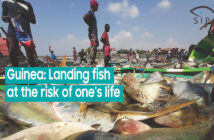In Zarrat, a coastal town south East of Tunisia, at 30 kilometers of Gabes, the women clam collectors are at the mercy of intermediaries imposing low prices. The clam is a valuable kind of shellfish essentially destined for export, mainly to Spain and Italy. Bought from the women at prices between 3.5 (€1.5), and 4.5 dinars (€2), a kilo of clam is, within 48 hours, sold to a price 10 to 15 times higher at the European market.
At the beginning of this activity, in the 1970s, the price of a kilo of clams paid to the women was three to four times more, at around 12 dinars (€5.4). This drastic fall in the price is mainly due to the proliferation of intermediaries. According to Zaabi Mosbah, President of the group for the operation and development of clam collection, these “profiteers” have proliferated after the advent of the revolution. “As a consequence of the revolution, there was a change in the entire sector. This is primarily due to the lack of control”, he says.
While in 2010 this group consisted of 3000 to 4000 women clam collectors, today only 72 are left. Discouraged by the fall of the purchase price, many women clam collectors left the group, which was unable to guarantee them remunerative prices.
 Harvesting clams is an activity practiced mostly by rural women, living in precarious conditions. At low tide, wearing rubber boots, women scatter over several kilometers of beaches. Every day, between five o’clock in the morning and 3 o’clock in the afternoon, under a blazing sun, they travel long distances, their back bent, sinking up to their knees in the sandy mud.
Harvesting clams is an activity practiced mostly by rural women, living in precarious conditions. At low tide, wearing rubber boots, women scatter over several kilometers of beaches. Every day, between five o’clock in the morning and 3 o’clock in the afternoon, under a blazing sun, they travel long distances, their back bent, sinking up to their knees in the sandy mud.
Their only tools: A toothed iron rod of approximately 20 cm long, known locally as El Menjel, and a small plastic container in which they put the clams. The technique of clam fishing is to locate the clam thanks to the two small holes in the sand caused by the two clam’s siphons.
Women then drive the iron rod down the hole and eject the animal. It’s a painstaking job, and only the most experienced women can fish two to three kilos of clams per day, earning between 12 and 15 dinars (between €5 and €7).
Poverty stricken, with no support whatsoever, and with their sole livelihood being the harvesting and sale of clams, women faces a number of constraints that accentuate their vulnerability. One of the major hurdles is the recurrent closure of clam fisheries zones, either for sanitary reasons or to limit exploitation of the resource. On average, the clam fisheries are open only 70 days of the year. Most of them illiterate, women clam collectors also lack appropriate training and coaching to develop alternative revenue-generating activities.
 Finally, these women heavily depend on often unscrupulous intermediaries. “The clam fishing zones are far away from where women live. Under these circumstances, the transport of women is provided by the intermediary himself. If a woman refuses to sell him her clams at the price he proposes, he will then refuses to take her in his truck”, explains Zaabi Mosbah.
Finally, these women heavily depend on often unscrupulous intermediaries. “The clam fishing zones are far away from where women live. Under these circumstances, the transport of women is provided by the intermediary himself. If a woman refuses to sell him her clams at the price he proposes, he will then refuses to take her in his truck”, explains Zaabi Mosbah.
Women clam collectors have no other possibility to sell their products; they have to go through these intermediaries who are mostly designated representatives of export centers located in Sfax, more than 200 km of Zarrat. Under these conditions, regardless of how derisory the price offered to them is, the women are forced to sell.
For them, it is a question of survival. “The day I work, I eat. If I do not work, I do not eat. It’s as simple as that”, says Zeyna who has been collecting clams for 36 years. “I have been doing this job for so long that I can’t do anything else. I carry on especially for my children, although even those who have studied are not working. What I want is for my children to find a job to help me”, she adds.
An impoverished population, Tunisian women clam collectors all dream of better and fairer prices for their products, which would give them a life in dignity.
Inoussa Maïga
@MaigaInou




